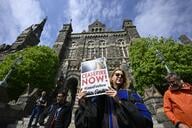You have /5 articles left.
Sign up for a free account or log in.

Illinois Tech has announced plans to open the first branch campus of a U.S. university in India.
Photo illustration by Justin Morrison/Inside Higher Ed | Scott Benbrook/Illinois Institute of Technology | naveen0301/iStock/Getty Images
On Wednesday, the Illinois Institute of Technology announced it had reached an agreement with India’s University Grants Commission to establish a branch campus in Mumbai, opening to students in fall 2026. It will be the first degree-granting U.S. institution on Indian soil and Illinois Tech's first international branch campus.
For decades, a complicated legal and tax system prevented U.S. institutions from opening campuses in India. Then, in 2020, the Indian government issued a new National Education Policy paving the way, officials promised, for a much easier pathway to fruitful academic partnerships.
India is a major growth market for U.S. higher education; this year the country surpassed China for the first time as the top origin country for international students in the U.S. Establishing a beachhead in India could help institutions carve out a dominant space for themselves in the lucrative international recruitment market, especially since the vast majority of Indian international students come to the U.S. for postgraduate study.
When the Indian government announced the NEP 2020 plan, officials envisioned the “top 100 universities in the world” setting up shop in the country. So far, that hasn’t happened.
Illinois Tech is not a globally renowned university; it’s not even one of the better-known institutions in Chicago. Its undergraduate population numbers only around 3,000 students, and the postgraduate population isn’t much larger. So how did it get ahead of name-brand research universities that have been dipping their toes in the Indian market, like Johns Hopkins and Rice?
Philip Altbach, professor emeritus at the Center for International Higher Education at Boston College and a longtime expert on academic internationalization, said American institutions have been hesitant even in recent years to invest in Indian branch campuses due to a mix of bureaucratic complications and uncertain financial returns.
“There hasn’t exactly been a rush to the gates in India from American institutions, and I don’t think there’s going to be anytime soon,” Altbach said. “The challenges of doing business there are still pretty high, and that puts a lot of foreign universities off.”
Illinois Tech president Raj Echambadi said his university is taking the long view. As the spending power of India’s burgeoning middle class grows along with demand for highly trained workers—especially in engineering and technology—he sees the Mumbai campus as an early investment in a partnership that will become central to American institutions’ global strategies in the years to come. His institution has already begun to see the importance of Indian students to their bottom line: The share of Indian master’s students has risen by nearly 75 percent over the past five years.
“The potential upside is huge, which means if you get in early the ride is going to be phenomenal,” he said. “In the next 25 years, we’re going to be catching that elephant’s tail.”
Illinois Tech had a head start on the competition: The institution has been active in the Indian education market since 1996, during a period of rapid technological innovation.
When demand for skilled workers in exploding fields like communications technology skyrocketed in the mid-1990s, Illinois Tech offered an early version of distance learning, shipping VHS-tape lessons to engineers in Bangalore who wanted to earn credentials that the Indian higher education system had yet to develop.
Now, Echambadi says, Illinois Tech is meeting new demands in a changing Indian economy; its Mumbai campus will offer 10 degree programs in growth fields like semiconductor engineering. It even has some built-in brand recognition: It’s known as IIT in Chicago, the same acronym as India’s main university system, the Indian Institutes of Technology.
“India can’t build universities fast enough to meet the growing demand,” Echambadi said. “That’s where we come in.”
Colleges Hang Back
Many colleges that wanted to explore opening a campus in India simply may have struggled to navigate the complex application system, even after the NEP was issued. Rajika Bhandari, a longtime international education strategist and the founder of the South Asia International Education Network, said the 2020 NEP took years to translate into practice.
“U.S. institutions have been trying to enter the Indian market for years, well before the NEP. But the Indian bureaucracy and strict regulations have always been a challenge,” she wrote in an email. “Even with the NEP, it has likely taken a while to implement aspects of the policy and actually get things going.”
Having a 30-year presence in India, Echambadi said, helped ease the process. He added that it helped that both he and Mallik Sundharam—Illinois Tech's vice president for enrollment management and student affairs, who led the Mumbai project—are of Indian origin; both attended college there before moving to the U.S. for their graduate degrees. They said their understanding of their home country’s byzantine bureaucracy helped them navigate the system quicker than their competition.
Sundharam said there’s also a much more receptive attitude in India toward foreign universities and a simpler system. They applied to establish the Mumbai campus earlier this year, and the entire process, from submission to acceptance, took two months. More than 50 foreign institutions have applied to set up a campus in India this year.
“The Indian government has come a long way,” he said.
Altbach said U.S. colleges are more likely to establish joint degree programs with Indian universities than full branch campuses. Virginia Tech established the first of these in 2023, also in Mumbai. Other institutions, including Johns Hopkins and Purdue University, have stuck to research partnerships and exchanges. Rice, which was an early proponent of Indian-American higher ed collaboration, established a research center in Kanpur in early 2020, months before the new NEP was introduced. Altbach said he thinks branch campuses will remain the territory of “low- to midlevel research institutions” seeking to boost enrollment.
But Bhandari, an Indian immigrant and a close observer of the country’s booming education market, said Illinois Tech may be on the vanguard of a new push in academic internationalization.
As international enrollment in the U.S. staggers from President Trump’s policies to deport student visa holders and crack down on global academic partnerships, Bhandari said physical programs in growth countries like India will become increasingly important. There’s already evidence that Indian student mobility to the U.S. is on the decline: F-1 visa applications from India are down 34 percent from this time last year, according to a recent analysis by Chris Glass, a professor at Boston College’s Center for International Higher Education.
“Other universities are operating under the assumption that international markets will stay the same, but they won’t,” Sundharam said. “Students may not want to be mobile in five to 10 years. They will want quality higher education at their doorstep.”





